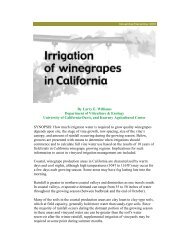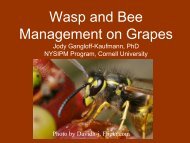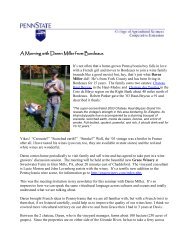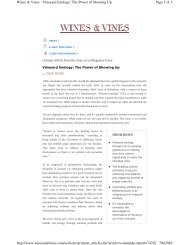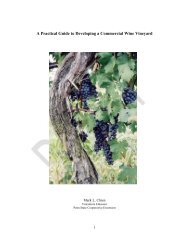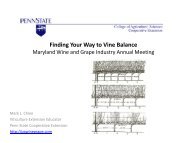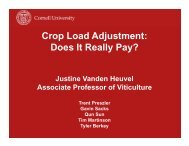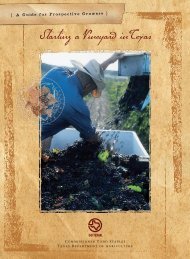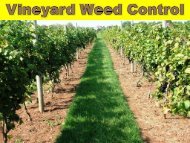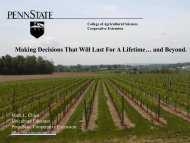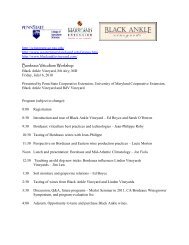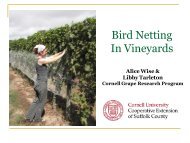Pinot Noir in Eastern N. America - PA Wine Grape Growers Network
Pinot Noir in Eastern N. America - PA Wine Grape Growers Network
Pinot Noir in Eastern N. America - PA Wine Grape Growers Network
You also want an ePaper? Increase the reach of your titles
YUMPU automatically turns print PDFs into web optimized ePapers that Google loves.
<strong>in</strong> Ontario said that his most important botrytis spray is applied shortly after bud break. In light<br />
of the early leaf removal work done by Bryan Hed (Penn State) and Stefano Poni (Italy), I am<br />
beg<strong>in</strong>n<strong>in</strong>g to believe that earlier efforts may be the most effective ones. I’ll rem<strong>in</strong>d you that Hed<br />
and Poni have found that the tim<strong>in</strong>g and severity of leaf removal can affect berry and cluster<br />
morphology and possibly reduce cluster compactness, <strong>in</strong>crease soluble solids and sk<strong>in</strong> to juice<br />
ratio, lower v<strong>in</strong>e yields and ma<strong>in</strong>ta<strong>in</strong> juice and w<strong>in</strong>e acidity. Another example we discussed was<br />
the effects of grape berry moth on rot <strong>in</strong> PN <strong>in</strong> 2011, where a cool, wet and late spr<strong>in</strong>g<br />
transformed <strong>in</strong>to a hot and dry mid-summer that led to a fourth flight of grape berry moth that,<br />
unfortunately, arrived after veraison just as the fruit was most vulnerable. If a grower did not<br />
address this threat at the proper time <strong>in</strong> the summer, then the fruit was <strong>in</strong> greater jeopardy at<br />
harvest. W<strong>in</strong>e grow<strong>in</strong>g still <strong>in</strong>volves a lot of star<strong>in</strong>g <strong>in</strong>to a crystal ball. But no one knows what<br />
the weather will be, so the prudent are anticipat<strong>in</strong>g and prepar<strong>in</strong>g for, if not the worst, then at<br />
least challeng<strong>in</strong>g conditions after veraison, when the fruit is most vulnerable and the weather<br />
counts the most. These upfront <strong>in</strong>vestments can pay big dividends at harvest but many growers<br />
are hesitant to utilize them for obvious time and expense reasons. If you are try<strong>in</strong>g to make great<br />
<strong>P<strong>in</strong>ot</strong> <strong>Noir</strong>, you really don’t have a choice.<br />
The <strong>P<strong>in</strong>ot</strong>s ga<strong>in</strong>ed <strong>in</strong> concentration and development mov<strong>in</strong>g from East to West, with those from<br />
the Niagara Pen<strong>in</strong>sula be<strong>in</strong>g among the most highly scored w<strong>in</strong>es from both v<strong>in</strong>tages. I tried to<br />
figure out why: are they simply better w<strong>in</strong>e makers, did less ra<strong>in</strong> at harvest allow for more ripe<br />
fruit, is their tendency towards higher density v<strong>in</strong>eyards the best design for high quality <strong>P<strong>in</strong>ot</strong><br />
production? Or is the lilt<strong>in</strong>g French accent of Sebastien and Jean-Pierre the music to PN must<br />
and w<strong>in</strong>e that makes them work harder to make f<strong>in</strong>e w<strong>in</strong>es? I th<strong>in</strong>k it is all of the above, and I<br />
conclude that mak<strong>in</strong>g great PN, or any w<strong>in</strong>e, is just a matter of f<strong>in</strong>d<strong>in</strong>g a good terroir, and<br />
apply<strong>in</strong>g the standard design and development pr<strong>in</strong>ciples, and management practices to it. For<br />
the record, the highest scor<strong>in</strong>g w<strong>in</strong>e (by a significant marg<strong>in</strong>) <strong>in</strong> the tast<strong>in</strong>g came from Billsboro<br />
W<strong>in</strong>ery on the west side of the north end of Seneca, with grapes com<strong>in</strong>g from Sawmill Creek and<br />
Verrill v<strong>in</strong>eyards, so the FLX are no slouch when it comes to f<strong>in</strong>e <strong>P<strong>in</strong>ot</strong>. Personally, I really like<br />
the 2009 Blair <strong>P<strong>in</strong>ot</strong> <strong>Noir</strong> from the Lehigh Valley and consider<strong>in</strong>g the v<strong>in</strong>tage conditions, this is<br />
a remarkable w<strong>in</strong>e. We know that with PN fully mature grapes are necessary to have any hope of<br />
mak<strong>in</strong>g f<strong>in</strong>e w<strong>in</strong>es, which means f<strong>in</strong>d<strong>in</strong>g the environmental conditions to achieve this. Quality<br />
of soil and climate are essential <strong>in</strong>gredients and they exist <strong>in</strong> all of the regions represented at the<br />
meet<strong>in</strong>g. The design element is also important, and it appears that v<strong>in</strong>e density plays a large role<br />
<strong>in</strong> achiev<strong>in</strong>g ripeness – higher density offers lower yields per v<strong>in</strong>e allow<strong>in</strong>g fruit to both ripen<br />
more successfully and earlier. Perhaps more to the po<strong>in</strong>t, a balanced v<strong>in</strong>eyard that achieves<br />
uniformity with<strong>in</strong> clusters, v<strong>in</strong>e and v<strong>in</strong>eyard, have the best opportunity to yield pleas<strong>in</strong>g w<strong>in</strong>es.<br />
While I cont<strong>in</strong>ue to believe that small v<strong>in</strong>es achieve the f<strong>in</strong>est red w<strong>in</strong>es, the <strong>P<strong>in</strong>ot</strong>s made by<br />
Morten Hallgren from Chris Verrill’s v<strong>in</strong>eyard, which is on a normal, mid-lake, east side of<br />
Seneca site, tra<strong>in</strong>ed to Lyre but <strong>in</strong> f<strong>in</strong>e balance, makes just the weight and elegance of w<strong>in</strong>e that<br />
Morten is seek<strong>in</strong>g. What must be the common denom<strong>in</strong>ator among all great v<strong>in</strong>eyards is the<br />
attention to detail, the balance and uniformity it embraces. I stress uniformity because a number<br />
of w<strong>in</strong>es that got d<strong>in</strong>ged were from v<strong>in</strong>eyards that lacked uniformity from problems such as<br />
w<strong>in</strong>ter <strong>in</strong>jury. I th<strong>in</strong>k there is no great secret to grow<strong>in</strong>g f<strong>in</strong>e <strong>P<strong>in</strong>ot</strong>. The climate may be the<br />
hardest part to get quite right. It really needs a cool place with an extended ripen<strong>in</strong>g season, and<br />
some consistency <strong>in</strong> weather behavior from year to year. The madden<strong>in</strong>g th<strong>in</strong>g for these growers<br />
is the dramatic variability from hot (2007, 2010) to cold (2009, 2011) as opposed to more gentle




